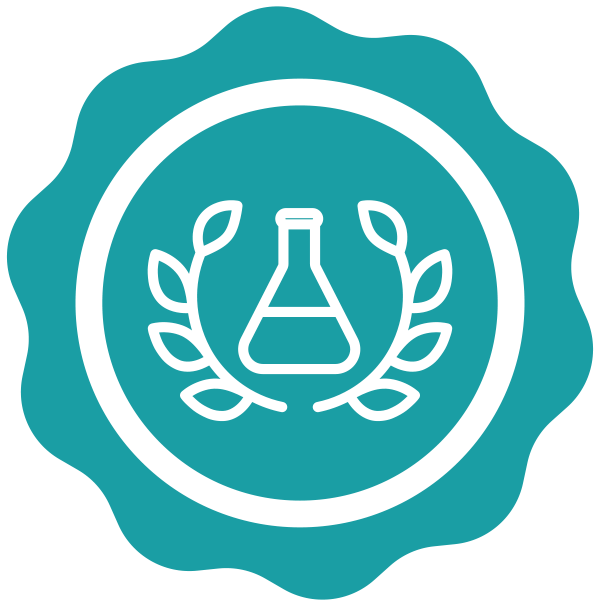
.png)

-modified.png)

From onboarding to metrics and productivity, the Lab Management Certificate (LMC) will provide the leadership and managerial skills that your organization needs to reach its business goals.
This certificate will help your leaders and managers contribute to your lab’s successful operations while heightening job satisfaction, improving retention, and reducing turnover.
Throughout each of the 20 courses, you’ll find real-life examples and activities that are truly relevant to your organization and applicable to all lab environments. Our lead instructor, Scott Hanton, PhD, has spent 30 years working in industrial chemistry labs with 20 years as a lab manager. He has expertly crafted each course to equip learners for growth and success in lab leadership.
Earn an official certificate delivered by an IACET-accredited institution. Plus, benefit from live office hours with our world-class lead instructor and enjoy lifetime access to course updates and revisions.
Unlock the skills and frameworks your organization needs to succeed within the competitive world of laboratory leadership with our fully comprehensive certificate.
.png)
.png)


Change Management
Change is required for all labs. Some changes are easy, and some are hard. It is natural for people to be hesitant and resistant to change. Lab managers can learn effective change management techniques that will create a compelling vision of the future, create a plan to achieve it, execute the plan to realize the benefits, and sustain the change into the future. Nurturing a culture of change and continuous improvement will make future changes easier and more effective. Learning Outcomes: Identify the difficulties of change, Integrate an effective change management process, Create effective communication, Determine the reasons why many change efforts fail, Recognize ways to identify the right changes.
Making Difficult Decisions for the Lab
Lab managers must make a wide variety of decisions. Some decisions are easy, but some decisions can be very difficult. Making difficult decisions requires a disciplined approach, benefits greatly from using the data available, and can be more effective when tackled as a team. This course is intended to provide a series of tips and advice to demonstrate an approach to making decisions, especially difficult ones. It will include some examples that show how the lab manager can approach these difficult decisions and include a few activities to help build skill and practice these approaches. Learning Outcomes: Summarize the importance of decision-making, Identify who will be involved in making decisions, Explain the importance of using data, Design follow through activities, Recognize the impact of decision fatigue.
Networking and Influence
Networking is the ability to cultivate a wide range of people that you can help, and who will help you. Networking is not a luxury—it is a vital skill for lab managers to develop and use. Influence is the ability to get work done through people over whom you have no authority. It is driven by trust and dependability. Influence is also a vital skill required to get work done across teams and organizations. Learning Outcomes: Identify the value of networking, Cultivate relationships needed for your network, Learn how to meet new people and add them to your network, Understand the benefits of influence and identify ways to build and grow influence, Use influence on behalf of the lab.
Making Data-Driven Decisions
Lab managers need to make a wide variety of decisions. Many of these decisions can be significantly improved by following a data-driven decision-making process. Using data in decisions will help make better decisions, be more objective, and enable more clear communication about the decisions. Learning Outcomes: Identify the importance of data, Make use of different kinds of data, Know where lab data is located, Integrate data in decision-making.
Negotiating Win/Win
Lab managers need to make a wide variety of decisions. Many of these decisions can be significantly improved by following a data-driven decision-making process. Using data in decisions will help make better decisions, be more objective, and enable more clear communication about the decisions. Learning Outcomes: Identify the importance of data, Make use of different kinds of data, Know where lab data is located, Integrate data in decision-making.
Lab Leadership Basics
Managing a lab is a big responsibility. It requires a significant amount of leadership knowledge and skill. This course will provide a broad introduction to the many leadership skills required of lab managers that they are rarely taught and have to learn through trial and error. Taking this course will enable the lab manager to better recognize which leadership skills are needed and have a firm foundation to apply those skills with confidence. Learning Objectives: Explain the importance of leadership, Identify foundational leadership skills, Integrate positive leadership traits into your lab management style, Design strategies for improved relationships.
Performance and Reviews
Providing staff with clear performance feedback, and helping them grow and develop is critical to the lab’s success. Addressing staff performance is a key role for all supervisors. Taking this course will enable the lab manager to design and create effective performance review conversations, determine key strengths of staff members, and create appropriate development plans to grow high performance and repair poor performance. Learning Outcomes: Improve performance with conversations, Generate effective performance reviews that include accomplishments, development, and a core message, Develop staff through their strengths, Provide paths to promotions through development plans, Meet expectations with performance improvement plans.
Roles, Responsibilities, and Objectives
Clearly defining what is expected of staff is critical to success. Lab managers need to know how to clearly define both the roles and responsibilities and the key objectives for each member of staff. Taking this course will enable the lab manager to select the most important aspects of a staff member’s position, developing effective roles and objectives documents, and identify and integrate SMARTER objectives into individual goals. Learning Outcomes: Learn the importance of developing effective roles and responsibility, and objectives documents, Select the most important aspects of the position, Identify and integrate SMARTER objectives, Create effective documents for staff.
Recruiting, Hiring, and Onboarding
Having a talented staff drives all of the success for any lab. Lab managers need to know how to differentiate candidates, conduct effective interviews, onboard new hires efficiently, and provide ongoing training. Taking this course will enable the lab manager to read resumes with greater confidence, conduct meaningful interviews, build an effective onboarding process, and develop training plans that make the best use of budget and resources. Learning Outcomes: Recognize that technical skill is less important than attitude, Identify important traits in candidates, Recognize effective ways to structure interview questions, Summarize the components of an effective onboarding plan, Describe the components of an effective training plan.
Skills Planning and Succession Planning
Determining and preserving the right mix of skills and expertise is vital for the success of the lab. Lab managers need to know how to conduct an effective analysis of the skills and expertise needed for the lab. The skills analysis will also drive investment, training, and hiring decisions. Succession planning is required to plan role and position changes as the staff evolves and changes. Learning Outcomes: Characterize skill levels, Current state skills analysis, Generate a key knowledge retention analysis, Determine the best future investments, Create an effective succession plan.
Effectively Advocating for the Lab
Effectively advocating for the lab is a critical role for the lab manager. Lab managers need to effectively prioritize the various needs, plan a strategy to communicate, advocate, and win some of what the lab needs to be successful, and influence people in the chain of command around approval decisions. To be successful, lab managers need to write effective business cases and be agile to accept feedback from key decision makers. Learning Objectives: Build plans for approval and evaluate alternatives, Understand the approval process, Navigate the approval process and influence approvers, Effectively write a two-part business case, Learn different ways to build the trust required to gain approval.
Lab Safety
Lab safety is a critical responsibility for all lab managers. Being comfortable with the requirements and elements of lab safety is necessary to generate an effective lab safety program. The lab manager must demonstrate safety by explicitly leading from the front, following the details of the program, and working hard to improve the safety performance of the lab. Learning Outcomes: List the number of fundamental elements of lab safety, Explain the responsibility of lab leaders to safety, Determine how to develop better safety habits, Explain the fundamentals of a lab safety culture, Recognize how and where to improve lab safety, Integrate the basics of emotional and psychological safety into your lab.
Lab Quality
All labs want to deliver high quality science that meets the requirements of their key stakeholders. Building the appropriate quality management system (QMS) helps the lab meet these goals. The right QMS will improve the lab’s document control, documentation of appropriate processes and procedures, consistency, communication, ability to improve, and help keep the staff engaged with quality work. Learning Objectives: Understand the value of a lab quality program, Identify the elements of a lab quality program, Differentiate the benefits of some different lab quality standards, Recognize the benefits of having an accredited QMS, Describe how to prepare to be accredited.
Asset Management
Assets are the things the lab uses to create value. Labs have many different kinds of assets. The most important is the people on staff. Lab managers must invest in, effectively use, and protect the lab’s assets. Due to competing priorities, lab managers must find the right balance of investments in the assets to meet budget and deliver technical value. There can be a variety of alternatives around obtaining and maintaining the assets required by the lab. These alternatives need to be investigated to find the high-value choices. Learning Outcomes: Provide examples of the different kinds of assets available in the lab, Determine the steps involved in a capital purchase, Determine the alternatives that exist to obtain new instruments and equipment, Discover the alternatives to deliver repair and maintenance to existing instruments and equipment, Identify alternatives besides the trash for instruments that are no longer needed in the lab.
Metrics and Productivity
Building effective metrics enables better setting of goals and targets, and more clear understanding of performance against those targets. Having metrics that are balanced and reinforce one another enables the lab to improve the work processes, deliver for the stakeholders, and grow the organization. Aligning the key metrics with measures of productivity enables the lab manager to focus on the things that matter. Learning Outcomes: Identify the basics of lab productivity, Understand the importance of balancing metrics, Select metrics that matter most to the performance of the lab, Judge how different metrics can impact the performance of the lab, Reflect on the kinds of actions the lab manager can take to improve lab performance.
Employee Engagement and Well-Being
Enabling staff to thrive improves lab performance. Organizations can contribute to positive staff well-being. Engaged employees significantly outperform other staff in all important categories. Engagement is increased by meeting key staff needs: positive relationships at work, clear expectations, praise and recognition, coaching and feedback, use of strengths, and ongoing development. Learning Outcomes: Identify the benefits from a thriving staff and employee engagement, Recognize ways to improve organizational well-being, Recognize ways to implement emotional, and psychological safety in the lab, Identify the key staff needs for employee engagement.
Conflict Management and Resolution
Conflict resolution is a very important skill for lab managers to have because conflict resolution can be difficult and frustrating. Finding the facts and following a data-driven conflict resolution process are behaviors the lab manager can demonstrate to enable better conflict resolution. There is much to be gained with calm, kind, supportive, curious, healthy debate. Finding win/win outcomes can create cooperation out of enmity. Learning Outcomes: List the benefits of healthy conflict, Describe how healthy conflict can be a source of innovation and creativity, Demonstrate behaviors that will de-escalate conflict and lead to mutually beneficial solutions, Explain the benefits of following the facts to solve issues, rather than emotionally blaming people, Implement some characteristics of lab culture that will reduce unhealthy conflicts.
Positive Communication
Good leaders are almost always good communicators. Communication is vital to effectively receive and share information. Good lab managers realize that listening is the most important communication skill. Developing effective active listening skills is a high priority to be effective as a lab manager. When sharing information, it is important to craft messages to maximize the receiver’s ability to understand, process, and act on the information. It is the responsibility of the transmitter to ensure that the message can be properly received. Positive communication can help build stronger relationships. Learning Outcomes: Utilize the seven C’s of communication, Describe the importance of active listening and some ways to improve this important skill, Recognize the importance of positive communication and be able to implement it around the lab, Explain the six components of positive communication.
Understanding Personality Types
People have natural preferences in personality styles. These differences in personality can lead to conflict in the lab. Understanding the basics of personality type can help lab managers address the root of many interpersonal conflicts. Bringing personality types into conflict resolution helps educate lab staff about diversity and differences between people. It helps to shift the focus of the conflict resolution to the facts of the situation and away from the individual personalities. Personality types describe preferences, not skill, and should never be used to limit people. Learning Outcomes: Identify the 16 different Myers Briggs Type Index, or MBTI, types, Explain the differences between the four MBTI pairs: E/I, N/S, T/F, and P/J, Use the MBTI temperaments to gain insight into how lab staff behave, Demonstrate the difference between preferences and skills, Identify how to apply personality type information to improve conflict resolution in the lab.
Creating an Environment of Success
Many people think that an organization’s culture and work environment are fixed. However, lab managers can have significant impact on creating a more positive culture, and a work environment that can enable success, both for the lab and for the people. Developing an environment for success requires attention to the details that affect the staff, like listening, caring, and learning. Learning Outcomes: Recognize ways to develop a positive work culture for the lab focused on emotional safety, shared vulnerability, and purpose, Implement active listening as a key leadership tool, Clarify the value of developing independence and ownership in the lab staff, Utilize staff development to improve the lab, Explain the benefits of being customer focused to the lab.
| Starter | Pro | Premium | |
|---|---|---|---|
| 5-15 Users | 15+ Users | 25+ Users | |
| Standard reporting dashboard | ✓ | ✓ | ✓ |
| Dedicated customer success manager | ✓ | ✓ | ✓ |
| Flexible course packages | ✓ | ✓ | ✓ |
| Detailed, automated reporting | ✓ | ✓ | |
| Custom payment terms | ✓ | ✓ | |
| Customized fireside chat quarterly | ✓ | ✓ | |
| Virtual instruction opportunities | ✓ | ✓ | |
| Custom-developed course content | ✓ | ||
| White-labeled interface | ✓ | ||
| Team learning dashboard and management system | ✓ | ||
| 1:1 guidance on custom course accreditation process | ✓ | ||
| In-person instruction opportunities* | ✓ | ||
| 10% off | 20% off | Contact us for pricing |
Complete the form below and a member of our course advisory team will reach out shortly.